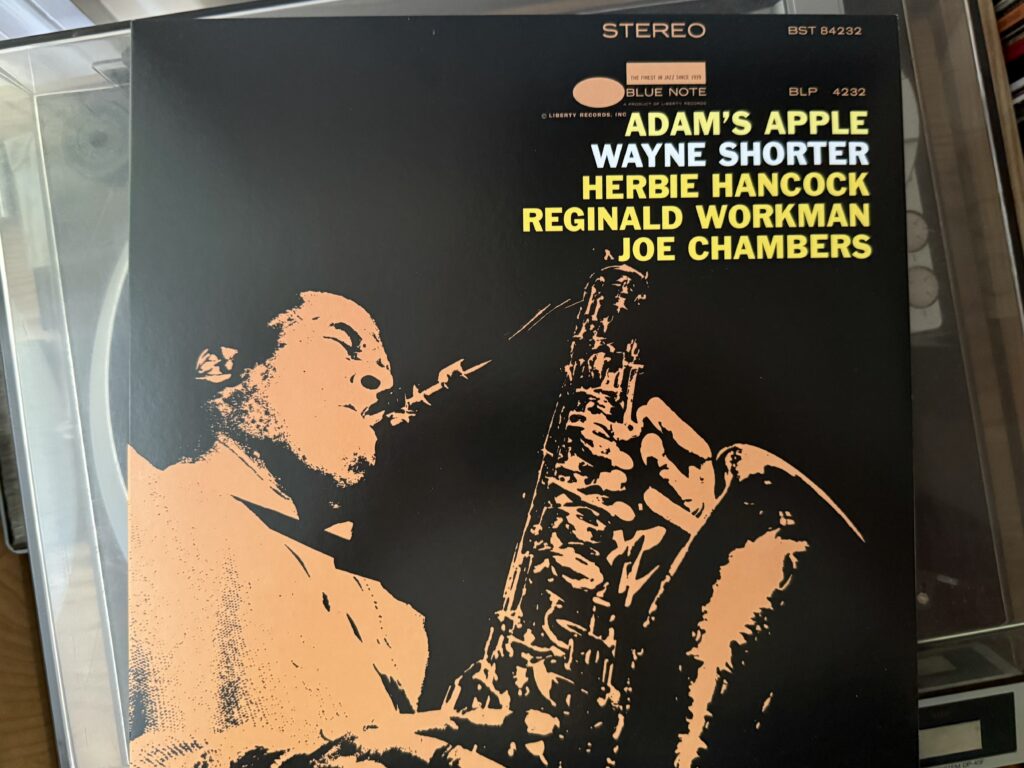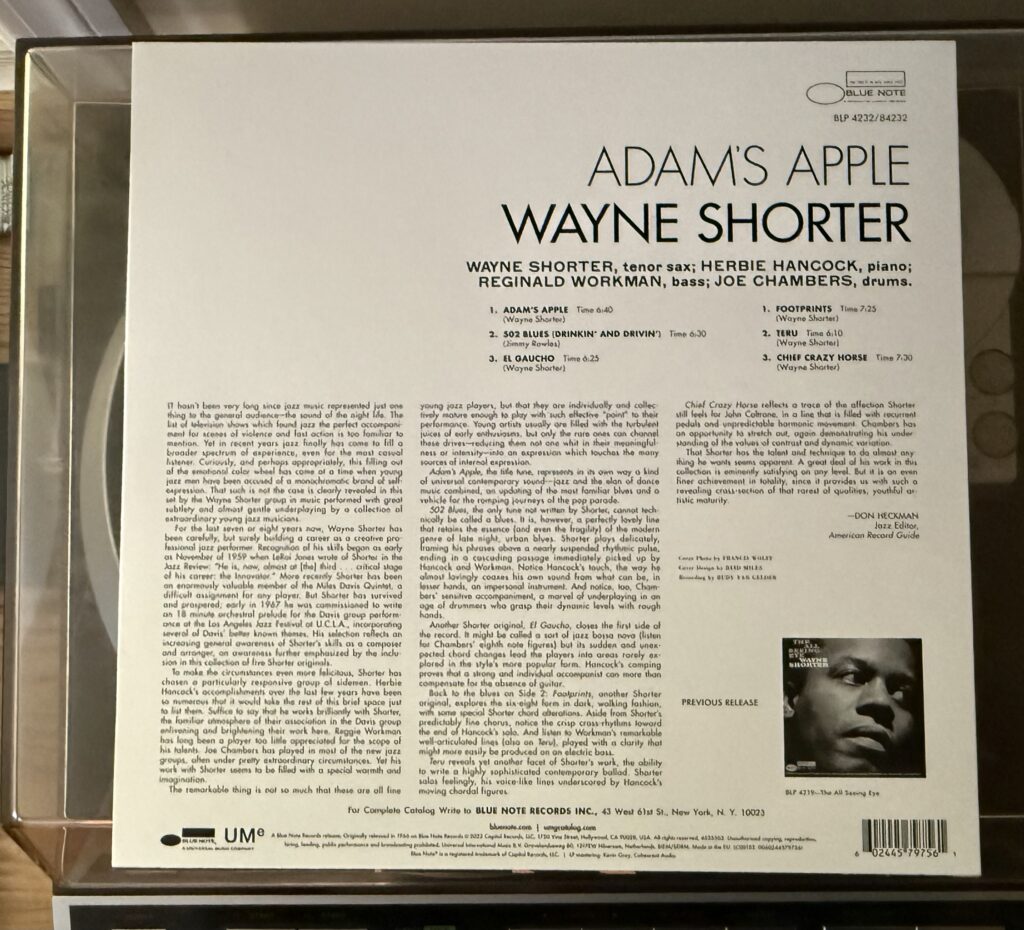
Album of the Week, October 12, 2024
Wayne Shorter as a composer in the 1960s was stretching his wings. Over the course of a few albums for Blue Note, he went from the Trane-inspired writings of JuJu to the incredible cool of Speak No Evil to the avant-garde leanings of The All Seeing Eye. For those who might have been expecting more of that latter album, recorded in late 1965, Adam’s Apple must have initially seemed a throwback. But this February 1966 recording, coming during the long break between E.S.P. and Miles Smiles, highlights two aspects of Shorter’s genius—his knack for a great melody and his prowess as a soloist. Supported by familiar bandmates Herbie Hancock, Reggie Workman, and Joe Chambers, the smaller forces on this album put a stronger spotlight on Shorter’s saxophone prowess, and it really shines.
“Adam’s Apple,” the lead track, is an insanely catchy blues that somehow answers the question “what if you combined the pop instincts of Herbie Hancock and Wayne Shorter on the same song?” The liner notes by Don Heckman call it a blend of jazz and dance music, but I think only in the sense that Vince Guaraldi’s “Linus and Lucy” is dance music (which it absolutely is). What’s striking here is Wayne’s solo, which manages to be bluesy and perfectly melodic without succumbing to the temptation to play all the notes, all the time. He leaves a lot of air around his playing in the arrangement, which Herbie happily colors with a soulful chord-forward accompaniment and solo. (This is presumably before Miles had the “butter notes” conversation with Herbie; his playing still has some of the exuberance of his earliest work here.)
“502 Blues (Drinkin’ and Drivin’)” is the sole cover on the album. Written by Jimmy Rowles, the work, despite the “party time” title, is unexpectedly subdued. It opens with a figure in Herbie Hancock’s piano for four bars, then continues with the tune, a ballad in A minor. Shorter’s solo seems to peek around the corner at us, wandering into a relative major for a brief moment before circling back to the original tone via a circular path, as if climbing a staircase. Herbie’s solo digs into the soulful corners of the tonality over the crisp swing of Joe Chambers’ snare and cymbal work.
“El Gaucho” opens with a brisk Latin rhythm in the bass and drums, leading us to ask whether a samba might be afoot. Perhaps one played by aliens; the tune takes us through five different keys, building on the same rhythmic backbone in each key, then rolling into a Wayne Shorter solo that seems to revel in hoquetus and interruption as much as it does in melody. The tempo is bubbly and the overall performance is too, with Hancock keeping things moving along. The pianist’s solo leans into the slightly Caribbean rhythms while also embracing chromatic movement between the different keys of the work. When Shorter returns with the melody, it’s as if to remind us of the mystery at the heart of it all—the tune circles around without resolution, constantly repeating and never really ending.
The most famous of Shorter’s compositions on the album is undoubtedly “Footprints.” Here in its first recording, about eight months before the Quintet essayed it for Miles Smiles, the tune is the same but the performance is totally different. For one thing, Wayne’s original tempo is more restrained than Miles’ (the evolution of which you can hear on Freedom Jazz Dance: The Bootleg Series, Vol. 5). This performance also swings more, led by Joe Chambers and Reggie Workman’s rhythm section. Again, we are in a blues, but one built on echo-like repetition throughout the main melody. Wayne’s solo pushes at the edges of that repetitive melody, finding other melodic patterns and at one point even beginning what feels like a “Love Supreme” like circle-of-fifths migration before handing back over to Herbie Hancock. Herbie plays an unusually verbose solo, responding to some of the “sheets of sound” like hints in the end of Wayne’s solo before finding a countermelody and alternate rhythm that seems to point ahead to the ingenious polyrhythm that Tony Williams famously found in the piece when the Second Great Quintet got into it. Reggie Workman’s solo finds unexpected scale runs in between the chords before the tune returns once more.
“Teru” is cut from a similar cloth to Wayne’s other great ballads from this period, looking back to “Iris” and anticipating “Nefertiti” and “Fall.” It’s contemplative and a quiet miracle, as Wayne and Herbie appear to read each others’ minds throughout the piece, which is played more as a duet with quiet rhythm section accompaniment than a solo with trio backing. One can only imagine what the Quintet would have done with this one; Joe Chambers is lovely in his solo but Ron Carter would have eaten this one up.
“Chief Crazy Horse” closes out the album (at least in the original vinyl release; later CD and digital reissues append “The Collector,” a Herbie Hancock composition recorded during the sessions but not issued until 1979, when it became the title track for a Japanese release of other Shorter odds and sods). The ending track is strong, with the rhythm section swinging through as though being suspended on swinging iron chains—moving, but with some serious momentum. Wayne subverts the climbing tune by diving down an octave at the opening of his solo and seemingly side-stepping into a completely different tonality; whenever Herbie piles on the chords, he responds with suspensions and slow moving notes, until the pianist gives room and he responds with a step forward, swinging through the changes. Herbie’s solo brings all the momentum forward, exchanging pounding chords with Joe Chambers’ truly apocalyptic drum rolls. This may be the only of Wayne’s compositions to dwell so happily in triplet meter; even when Herbie’s solo starts out in common time it soon finds its way to triples. The final melody, like “El Gaucho,” fades rather than ending; we imagine the chief riding into a desert sunset aboard a horse with waltz-like tendencies.

As Wayne’s impeccable series of small group albums on Blue Note continued through the decade, the cheery optimism of Adam’s Apple was soon to give way to the more abstract searchings of Schizophrenia and Super Nova. But this album stands as a milestone among Wayne’s 1960s output as a showcase for both his composition and his soloistic verve.
Next week we’re going to hop ahead about ten years, past the dissolution of the Quintet and the advent of jazz fusion, and check in with our players on the other side of that historic movement.
You can listen to this week’s album here:
BONUS: While “Footprints” was covered almost from the moment of its writing, the other compositions on Adam’s Apple are also endlessly coverable, and have been visited by young jazz artists in the past 20 years as they encounter Wayne’s legacy. I put together an alternate running of the album with covers of each of the tunes to show you what I mean. (Updated to point to an Apple Music playlist since one of the videos on the original YouTube playlist became unavailable.)

Great reviews of Wayne & Co. Still sounds new,with much to (re)discover.
BUT- what’s up with the video that’s N/A right above? Hope that gets figured out as we all would love to see it!
I just came over due to a link from Ken Mc.- I’ve got a bit of catching up to do…
Thanks.
😎
Thanks for the heads up! Looks like since Saturday the lead track on the playlist, Walter Smith’s cover of “Adam’s Apple,” has disappeared from YouTube. 🙁 Will see if I can find a different way to post the playlist.